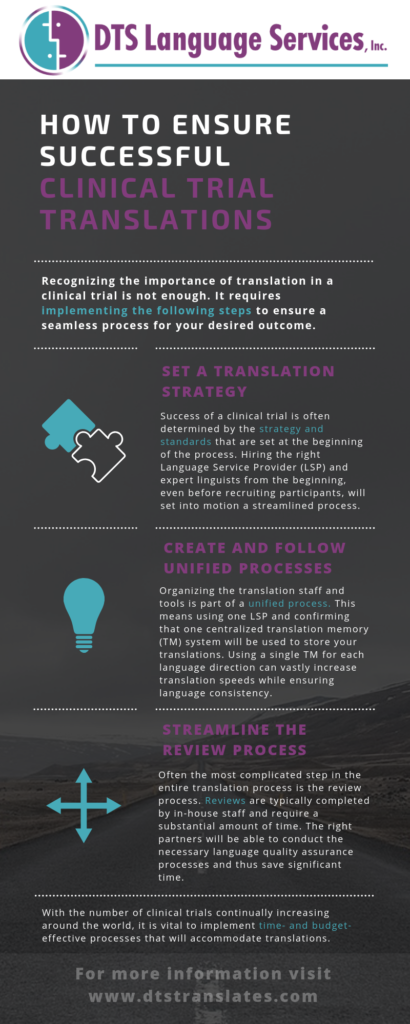In the last ten years, the number of clinical trials has quadrupled. We’re only halfway through 2018 and there are currently over a quarter of a million clinical trials registered around the globe.
That last phrase, around the globe, is key to understanding the rapid expansion and necessity of clinical trial translation. Globalization has had a profound effect on the way both pharmaceutical companies and Clinical Research Organizations (CROs) conduct their clinical trials. While communication of medical terminology is already challenging, growth into different cultures and languages adds serious complexity to the clinical trial process. In addition, ensuring documents are translated accurately has consequently become another hurdle that Clinical Trial Managers have to successfully clear.
You cannot allow critical information to be overlooked or to get “lost in translation.” From recruitment to the review process, expert linguists and translators are an important part of ensuring your clinical trials are efficient, cost-effective and successful around the world.
Recognizing the importance of translation in a clinical trial is not enough. It requires implementing the following steps to ensure a seamless process for your desired outcome.
Step 1 – Set a Translation Strategy
The importance of being prepared for language complexities cannot be underestimated. An error in communication can compromise the entire process. Success of a clinical trial is often determined by the strategy and standards that are set at the beginning of the process.
It is not enough to recruit a bilingual staff member to translate the complicated terminology of a medical process. Furthermore, you cannot assume that any translator can effectively communicate sophisticated instructions or transcribe the detailed documents without error. The accuracy of translation must be seamless across the board to produce the necessary documents like clinical trial agreements (CTAs) and informed consent forms (ICFs) among others.
Hiring the right Language Service Provider (LSP) and expert linguists from the beginning, even before recruiting participants, will set into motion a streamlined process. The LSP you choose should have procedures to develop a comprehensive strategy tailored to meet your project’s specific needs, to conduct a selection process that effectively qualifies the translators being used, and to ensure quality translations upon delivery.
Step 2 – Create and Follow Unified Processes
Part of the strategy for creating a successful clinical trial should include organizing the translation staff and tools you use into unified processes. This means using one LSP and confirming that one centralized translation memory (TM) system will be used to store your translations. Using a single TM for each language direction can vastly increase translation speeds while ensuring language consistency.
While the order of each step may vary, be sure to execute a complete translation process that includes:
- Forward (and possibly Back) translations
- Clinical review
- Harmonization
- Linguistic validation
- Cognitive debriefing
- Pilot testing
- Finalization report
While standard translation projects will often go through a translation and then one subsequent review cycle, clinical trial translations add several vital steps to ensure the final translations are acceptable and ISPOR/ISOQOL compliant (validated translations).
Step 3 – Streamline the Review Process
Often the most complicated step in the entire translation process is the review process. Reviews are typically completed by in-house staff (each with full-time responsibilities for other initiatives) and require a substantial amount of time. As a result, while the clinical trial translations may have been completed, unchecked review cycles may create delays of several weeks or months.
One way to ensure that your reviews are streamlined is to partner with an LSP with expertise in clinical trials. Consider it a bonus if the LSP is willing to work directly with the reviewers (whether internal or external) to ensure the translations are to the requested standards. The right partners will be able to conduct the necessary language quality assurance processes (and document them) and thus save significant time.
With the number of clinical trials continually increasing around the world, it is vital to implement time- and budget-effective processes that will accommodate translations. Working with a centralized LSP is an essential part of the process. Not only will you reduce time and costs, but you’ll increase the value you deliver to your clients and ultimately, to patients.



